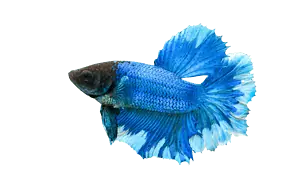The radiant, vibrant Crowntail Betta, also known as the Siamese fighting fish, is a spectacle in the aquatic world.
Its segmented, flaring tail fins resemble a regal crown; hence the name Crowntail, lending this Betta variant an air of royal elegance, complemented by a saw-edged outline adorning its beautiful fins.
Every ‘Siamese fighting fish’ has unique needs – they’re as individual as humans.
Observing our royal friend, the Crowntail meander in an aquarium might suggest a common “care guide,” but this species requires special attention to thrive in all of its aquatic majesty.
These “care guide” specifics are vital because when it comes to these fish, the notion of one-size-fits-all simply doesn’t apply!
Table of Contents
Physical Characteristics of Crowntail Betta

Appearance
Fin Shape and Size
Bettas, especially crowntail bettas, are known for their distinctive fin architecture.
This architecture is seen as a battlement-like pattern that sweeps outward, reminiscent of a royal crown.
Of course, compared to other betta varieties, crowntail bettas sport uniquely sharp fin rays and extensions that are entirely the product of genetics.
While other bettas might have smoother, rounder fins, these fin extensions add a touch of regal charm to any aquarium!
Color Variants
The color palette of a Crowntail Betta hosts an array of colorful fish, each rivaling the variety at the end of a rainbow.
Their scales light up in different colors and shades, from the fiery passion of red to the serene calm of blue and the pure luster of white.
Although vibrant red shades are commonly sighted due to genetic dominance, rare hues like turquoise and gold make these fish shimmer like underwater treasures.
Indeed, these Bettas, in a multitude of different colors, are not just resilient fighters; they transform aquariums into dynamic art spaces, bustling with the playful dance of colorful fish.
Male vs. Female Differences

Size Differences
In Crowntail Betta circles, size truly matters.
Males average at 2.5 inches, while slightly smaller females don’t significantly impact tank needs.
Don’t let their petite stature deceive you; they pack a vibrancy and flamboyance that’s impossible to ignore.
Coloration and Fin Shape
Our male Bettas would be the catwalk superstars in an underwater fashion show.
Their dazzling colors and show-stopping fin display — a byproduct of their flamboyant sexual selection, overshadow their striking female crowntail betta counterparts.
These males are unapologetically extravagant like proud peacocks, sashaying their radiant looks around the tank.
Behavioral Differences
Male Crowntail Bettas flex their unique territoriality, a trait often related to “only child syndrome.”
This feisty nature tends to influence the choice of tank for a betta and the selection of potential tank mates, making it clear why many fish keepers often say betta fish are aggressive.
On the flip side, female bettas exhibit a more chill attitude, making them tropical fish that easily fit into various tanks without asserting dominance.
So, while male bettas box like heavyweight champions, the ladies enjoy a more peaceful swim in the neighborhood.
Size and Lifespan

Average Size
A fully-grown Crowntail Betta barely stretches 2.5 inches.
They stand true to their “compact” classification without compromising their larger-than-life demeanor.
Typical Lifespan
Crowntail betta care is critical in managed environments, as their average lifespan is 3 to 5 years.
This crowntail betta lifespan can be further enhanced by key elements such as diet, water quality, and stress management.
Providing a balanced diet, pristine surroundings, and an environment free of stress promotes a longer, more vibrant life for these aquatic stars of the tropical freshwater fish world.
In essence, Crowntails, amongst the wide range of betta fish varieties, offer an intriguing contrast: small yet lively, vibrant yet fierce.
Their unique lifestyle, honed by selective breeding, and irresistible aesthetics continue to enchant fish enthusiasts and experts alike.
For their captivating vibrancy or territorial nature, crowntail bettas command attention, truly living up to their regal moniker within their aquatic realms.
Natural Habitat and Origins of Crowntail Bettas
Geographic Range
The Crowntail Betta (Betta Splendens), one of the exciting species of betta, calls the balmy shallow rice paddies and leisurely rivers of Southeast Asia home.
This unique fish species primarily hails from countries such as Thailand, Malaysia, Cambodia, and Indonesia.
Their spectacular appearance comes from living in slow-moving or stationary water bodies that mimic their natural vegetation-cloaked landscapes, brimming with warmth and tranquility.
Water Conditions in Their Wild Habitat
Crowntails in the wild often navigate many challenging conditions, like low oxygen waters.
However, as labyrinth fish, they’ve mastered the ability to breathe atmospheric oxygen—a neat trick that helps them thrive in oxygen-depleted zones.
These particular bettas usually enjoy basking in balmy climes of 75 to 80 degrees Fahrenheit with a water pH ranging from slightly acidic to neutral.
The water is typically teeming with various plants, softening it to a moderate hardness.
Keeping your fish, specifically your betta fish tank, as close to these conditions as possible will ensure maximum comfort and well-being for your Crowntail.
This includes but is not limited to maintaining the right temperature, pH level, and providing access to surface-level oxygen (glub!).
Remember, closely mimicking their natural habitat is the golden ticket to keeping your betta fish happy and healthy.
So, what are we waiting for? Time to sprinkle a little Southeast Asian magic onto your betta fish tank!
You’d be surprised at how much they love floating plants and the overall feel of a planted tank.
Care Requirements for Crowntail Betta
General Tank Requirements for All Bettas
Each unique Betta fish prefers their very own space, perhaps in a 5-gallon tank, which offers them an adventurous exploration of their environment.
Filtration and aeration are not just important; they’re essential!
They ensure water quality while maintaining a pH level between 6.4 and 7.0 – a level Betta species find ideal for their well-being.
As you might imagine, they’re not too different from us when it comes to enjoying clean, well-balanced surroundings!
Specific Tank Requirements for Crowntail Betta

Ideal Tank Size
With their extravagant fins, Crowntail’s love roomy spaces for optimal comfort.
A lively 10-gallon tank is perfect, but a minimum 5-gallon tank can also serve as an aquatic stage for these flashy fish.
Recommended Decor and Substrate
Offer your Crowntail a cushy sanctuary absent of sharp edges or rough surfaces.
A layout of velvety rocks, silk, or even live plants, such as Java Fern or Anubias, builds the perfect concealment spots.
Your chosen substrate should ideally be gravel, fine sand, or a compelling blend of both!
This will ensure a smooth underfoot terrain, decreasing the chances of fin damage and keeping it prim and proper.
Diet and Nutrition

Types of Food
Crowntail Bettas thrive on protein-rich diets.
High-quality Betta pellets, bloodworms, and other fish foods like brine shrimp and daphnia offer a delightful variety in nutrition.
For utmost health results, jazz things up by mixing fresh food sources with frozen foods and flake foods.
This gives your pet a smorgasbord of flavors and essential nutrients!
Feeding Schedule
Feed adults twice daily: morning and night. Juveniles may require an extra midday snack, but be careful not to overfeed.
Health Considerations

Common Diseases
Like all Bettas, Crowntails may contract fin rot, pop-eye, and velvet disease. Hygienic tank conditions are your first defense.
Stay informed about your fish’s health.
Preventive Care
Regular water changes maintain pristine conditions for your Betta.
Believe it or not, vet check-ups are possible for fish and assist in early issue detection.
Your care routine should promote a clean, stress-free environment for your Betta.
After all, health is wealth, even underwater!
Behavior and Temperament

General Behavioral Traits
This extravagant male crowntail betta, distinct in the underwater realm, is quite a spectacle.
Known for their stunning fin ballet, these lads embody the mesmerizing rotations of a flamenco dancer mid-pirouette.
But within them hides a fierce intensity, ready to spring into action faster than the punchline of a well-rehearsed dad joke.
Male crowntail bettas prefer the luxury of solitude over being a social butterfly, carrying a reputation for intense aggression.
They’re more likely to assert dominance against their reflections or potential rivals.
Be warned; putting them in close proximity in small tanks can ignite some aggressive confrontations, and we’re not talking about a cheering crowd at a sports game.
Furthermore, they are fiercely territorial creatures.
They can be found marking their space when not busy flashing their gorgeous fins or embarking on tank exploration escapades.
They stand ready, prepared to ward off any seeming threats in their habitat.
Social Dynamics with Tank Mates
Introducing new pals into a Crowntail Betta’s 5-gallon tank dwelling needs tact.
They’re generally grumpy, selective, and strict about their tank buddies, especially those rocking a caudal fin.
Though they can be noticeably hostile towards their likeness or similar species, Crowntail Bettas cohabit peacefully with other distinct species.
Avoid introducing bright or flashy tank buddies, as these could arouse the Betta’s territorial instincts.
Consider the tank’s size and available cozy corners when bringing in new mates.
Stuffing too many friends in can spark Mr. Grumpy’s lively temperament, and too few hideouts could skyrocket their stress levels.
To ensure peace, keep them with polite or nimble species that won’t give chase and nip fins.
Implanting a Crowntail Betta into a communal underwater scene demands strategic planning, observance, and patience.
Despite the hurdles, one thing’s certain – their addition guarantees a lively tank full of fascinating dynamics!
Compatibility and Tank Mates

Creating balance in your aquarium requires thoughtful choice of tank mates, ensuring harmony for your Crowntail Betta.
Let’s explore what fishes to celebrate or dodge like a swift dart to food.
Good Tank Mates for Crowntail Bettas
The feel of your fish tank, like a rollicking social gathering, can be thrown off by disharmonious guests.
Thankfully, many types of buddies make excellent roommates for your Betta:
- Snails: Leisurely yet efficient, snails are the perfect accomplice for your Betta – cleaning without imposing on their turf.
- Ghost Shrimps: Industrious and nearly undetectable, they amplify tank hygiene while seamlessly veiling from the Betta’s notice.
- Neon Tetras: Gentle and flashy dwellers of the topmost water strata, bestowing your Betta ample space beneath. Always remember sharing is fish-friendly.
- Cory Catfish: Known for their serene nature, these floor-level swimmers avoid bothering your Betta, advocating tank harmony.
- African Dwarf Frogs: Surprisingly, these substrate-dwelling frogs steer clear of squabbles, making them fitting tank buddies.
Species to Avoid for Your Crowntail Betta’s Tank
Every hero has a villain; your Betta is no exception. Meet their nemeses:
- Gouramis: Terribly territorial like Bettas, cohabiting can create a tempest in your teapot.
- Barbs: Specifically, the Tiger and Cherry variants. Known fin-nippers, they’re the Betta’s least favorite.
- Slow Swimmers and Bright Fish: Mistaken as foes, their presence can provoke your Betta into combative mode.
- Large, Aggressive Species: Avoid Oscars and Cichlids. Too big, too brash, and perilously likely to snack on your Betta.
Ultimately, your Betta’s well-being depends on a wise selection of companions.
Choose wisely, and you might spot your Betta “happy-flapping” its tail — if only it could!
Breeding
Required Conditions
Cultivating the flashy Crowntail Betta, also known as “breeding crowntail bettas,” demands precision and the right conditions.
They can be as finicky as teenagers scoffing at early bedtimes.
Kick-off with a distinct breeding tank just for your Crowntails.
A suitable tank would be a 5 to 10-gallon space; however, more elbow room is always welcome.
Fill it about five inches deep with water, but remember not all tap water fits the bill; a water conditioner should be used to neutralize harmful chemicals.
Keep the water temperature between 78 and 82 degrees Fahrenheit, making for a snug milieu, like a warm candlelight glow or a soft melody for your aquatic friends.
A sponge filter serves as a mellow filtration system which also doubles as a protective entity preventing the future offspring from being inadvertently sucked up – it’s like a cozy cot for future fish.
A well-adorned tank – a suitable tank, is crucial.
An abundance of plants (authentic or otherwise) offers hideouts, a necessity for a smooth courtship.
For that personal touch, situate a Styrofoam cup on the water’s surface; it’s an optimal location for Betta males to build their bubble nest or a “bubble palace” underneath it.
Lastly, to enhance their comfort, keep the lighting per their preference.
Common Challenges
Let’s dive into the wild love soap opera of our Betta beauties.
Getting the female Betta ready for the romantic tango is a pivotal factor.
Look for signs that the female is receptive, such as a shimmying dance and barred patterns.
She’s got to be into the groove, or a keen male’s ire might turn the romantic saga into a fiery spectacle.
The courtship dance between our protagonists can turn into a heated Jaws scenario if not observed.
Enter the brave knight, the one male crowntail, who must tread carefully amidst heightened aggression.
Remember, if things start to look more like “Fight Club” than “Pride and Prejudice,” it’s time to bring the curtain down and remove the female from the tank.
And here’s the secret. Patience is magic. Breeding Bettas can be likened to whipping up the perfect coffee concoction.
It’s not a race but a journey. With time, you’ll notice the bubble nest nearby, a clear sign of victorious Betta matchmaking.
Hold on tight as the female releases her eggs into the water, marking the climax of this epic romance.
Before long, you will become a master of the Crowntail Betta breeding stage. Enjoy the show.
Cost and Availability

Pricing Factors
Just like that coveted pair of shoes, the price of a Crowntail Betta varies. Fin Quality, Color Rarity, Age, and Breeder Reputation all contribute to the final cost.
Fin Quality
Fins for bettas are like feather boas in a cabaret show – the more stunning they are, the grander the applause!
Top-tier Crowntail Bettas—flaunting vivid, impeccable fins—are the pop stars of the deep blue, akin to the legends of the International Betta Congress!
Color Rarity
As elusive limited edition collectibles charge more, bettas with rare hues demand a premium.
Find an unusual color like lavender or mustard gas; you’d need to dig deeper into your pocket.
Age
Like a well-aged wine, a fish can get pricier as it matures. Younger fish might chip more off your savings due to their promise of longevity.
Still, older exceptional bettas can draw similar high prices, earning their stripes in this underwater fashion race!
Breeder Reputation
Much like designer products, breeder reputation significantly impacts betta price.
Renowned breeders charge more but assure well-cared bettas, minimizing future health concerns.
Availability and Where to Buy
Forget the neighborhood garage sale – put your trust in reputable pet stores or specialized aquatic shops when scoping out your Crowntail Betta.
Prime sellers wave bye to below-par deals.
Embrace the online fishbowl for a wide selection, but only with verified sellers.
Just be sure to swim through their credibility tests before sharing your card details.
All in all, hunting for a Crowntail Betta can seem like navigating the seven seas.
But armed with this guide, you’ll be sailing the pricing waves like a seasoned betta captain, even if that fish is more than just a few inches in size!
Frequently Asked Questions

Are crowntail bettas rare?
Crowntail bettas, the stars of the underwater realm due to their webbing-reduced, spiked tail fins, are not as rare as you’d think.
Scanning through pet stores or sailing across online suppliers, you will find them lurking in many corners.
However, securing a top-quality spectacle is a task akin to treasure hunting.
But diving towards fish like these and bringing home such an aquatic ally? Absolutely worth it!
Are crowntail betta fish more aggressive than other betta types?
Despite the tag, ‘Siamese fighting fish,’ a betta’s temperament swings more towards species than variety.
Therefore, your crowntail won’t be any more of a hothead than a halfmoon or plakat.
Here’s the kicker: ALL bettas channel a pinch of poutiness – imagine maintaining a furrowed brow underwater; wouldn’t that cramp your style?
Are crowntail bettas more difficult to care for?
Catering to the needs of any betta – crowntails being no exception – means comprehensive care encompassing warm water (78-80°F), a balanced diet, a neat habitat, and well-kept dkh (degree of hardness) parameters.
Don’t bother about timely bills unless your fish is feeling spendy!
With reduced webbing, their distinct tails might play hard to get, being prone to damage.
So, keep your eyes open for dead giveaways and handle with kid gloves.
With the right knowledge and a dollop of dedication, rearing a crowntail betta becomes an enjoyable, manageable venture!


